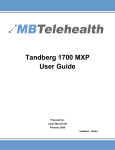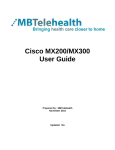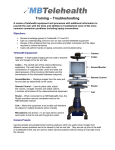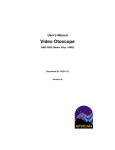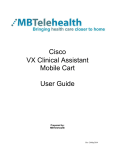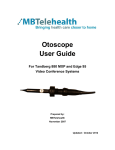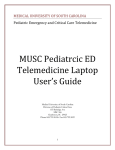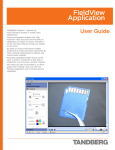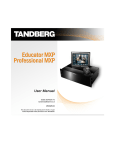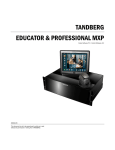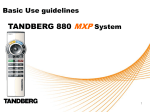Download Tandberg 880 MXP User Guide
Transcript
Tandberg 880 MXP User Guide Prepared by: MBTelehealth September 2006 Updated: October 2012 MBTelehealth – Tandberg 880 MXP User Guide TABLE OF CONTENTS 1.0 OBJECTIVES ......................................................................................................................3 2.0 THE TANDBERG 880 MXP.................................................................................................3 3.0 GENERAL SETUP AND USE .............................................................................................7 3.1 General Setup .................................................................................................................7 3.2 Mute/Microphone.............................................................................................................7 3.3 Camera Presets ..............................................................................................................8 4.0 PLACING AND RECEIVING A VIDEO CALLS ...................................................................9 4.1 Site to site........................................................................................................................9 4.2 Multi-site ..........................................................................................................................9 5.0 VOLUME..............................................................................................................................9 6.0 FAR END CONTROL ........................................................................................................10 6.1 Site to site......................................................................................................................10 6.2 Multi-site ........................................................................................................................10 7.0 PICTURE IN PICTURE .....................................................................................................11 8.0 DISCONNECTING FROM A CALL ...................................................................................11 9.0 LAPTOP/PC CONNECTION .............................................................................................12 10.0 LCD PROJECTOR ............................................................................................................13 10.1 Near End Presentation Through LCD ...........................................................................13 10.2 Far End Presentation Through LCD..............................................................................14 10.3 Near End Presentation with Video Splitter ....................................................................15 10.4 Near End Presentation w S-Video Out .........................................................................16 11.0 AMD PATIENT CAMERA CONNECTION .........................................................................17 11.1 Connection ....................................................................................................................18 11.2 Operation.......................................................................................................................19 12.0 N_SIGHT PATIENT CAMERA ..........................................................................................20 12.1 Connection ....................................................................................................................21 12.2 Operation.......................................................................................................................22 13.0 DOCUMENT CAMERA .....................................................................................................23 13.1 Connection ....................................................................................................................23 13.2 Operation.......................................................................................................................24 14.0 TELESTETH- ELECTRONIC STETHESCOPE ................................................................25 15.0 GLOSSARY OF KEY TERMS ...........................................................................................25 16.0 ACKNOWLEDGEMENTS..................................................................................................26 17.0 TROUBLESHOOTING ......................................................................................................26 17.1 Audio Issues ..................................................................................................................26 17.2 Video Issues ..................................................................................................................27 18.0 ADDITIONAL TRAINING INFORMATION ........................................................................27 APPENDIX A: TANDBERG 880 MXP QUICK REFERENCE ........................................................28 APPENDIX B: VIDEOCONFERENCING ETIQUETTE ..................................................................29 Page 2 of 29 MBTelehealth – Tandberg 880 MXP User Guide 1.0 OBJECTIVES This user guide will provide you with an overview of the Tandberg 880 MXP and the knowledge to setup and use the videoconferencing equipment. Learning Outcomes: After reviewing this guide, you should be able to: 1. Identify and explain the main parts of the Tandberg 880 MXP. 2. Use the remote control to navigate through the Tandberg 880 MXP menus, set camera presets, and access additional video sources. 3. Setup and use the equipment. 2.0 THE TANDBERG 880 MXP The main components of the Tandberg 880 MXP videoconferencing equipment are the Camera, Codec, Ethernet Cable, Microphone, Screen/Monitor, Remote Control and SVideo Cable Connector. THE EQUIPMENT AT A GLANCE 1. Camera - The built-in camera is a high quality imaging device which transmits images to the screen/monitor. The camera movements are controlled by a wireless infra-red (IR) remote control that controls a variety of functions, both on the near and far end. 2. Codec - The codec is the central part of the videoconferencing equipment. The main task of the codec is the compression of outgoing video, audio and data, the decompression of the incoming information and the transmission of this information between endpoints. The name codec comes from a combination of the two words compression and decompression. Page 3 of 29 MBTelehealth – Tandberg 880 MXP User Guide The Camera and Codec (front and back view) Codec Camera On/Off Switch RCA Inputs/Outputs S-Video Inputs/Outpu DVi Inputs/Outputs Microphone Connection Ethernet Connection 3. Ethernet cable - This type of cable is similar to the one that connects to the Local Area Network (LAN). One end is plugged into the back of the codec and the other end (for MBTelehealth purposes), must be plugged into the specified jack in the wall. Once the Ethernet cable is plugged in, you will be able to connect, or be connected to other sites. 4. S-VIDEO Cable - S-Video is short for Super-Video. Video signals are transmitted through a cable which is divided into two separate signals: one for color (chrominance), and the other for brightness (luminance). Ethernet Cable S-Video Cable Connector 5. Microphone - There are two types of microphones that accompany the videoconferencing equipment. The first may be located on the equipment and the second is the table microphone which is designed to be located on a flat surface in front of the participant. The microphone cable should always face towards the videoconferencing system. The system will automatically equalize sound levels so that loud and soft voices are picked up and transmitted to the far end at approximately the same level. Page 4 of 29 MBTelehealth – Tandberg 880 MXP User Guide 6. Screen/Monitor - The videoconferencing equipment may utilize single or dual screen/monitor configurations. The screen/monitor displays the far end or the near end image. 7. Router - When connected to an MBTelehealth drop, the Router provides a secure connection back to the MBTelehealth network 8. Remote Control - The remote control is used to place calls, adjust the volume, navigate screens and select options. It controls all functions of the videoconferencing equipment. When the remote control is not in use, it should be locked away; the equipment will not function without it. The Tandberg MXP Remote Control Video Sources switch between Main Camera, Laptop, Document Camera, DVD / VCR and Aux Mic Off turns your microphone on and off. The Presentation key switches to a predefined presentation source. Arrow Keys are used for navigation in the menu and for moving the camera Press Ok/Menu to show the menu and to select menu items. Volume + and – adjusts the system volume. The Layout key toggles between full screen and different display layouts. Press the Call key to place a call. Camera Presets define specific camera positions. Press and hold a number key for 1 second to save the current camera position to that number key. To activate a preset during a call, simply press and release that number key. Use Zoom + and – to zoom the camera in and out. Selfview video. displays your outgoing Use the red End Call key to end the current call. If you press this key and you are not in a call, the system will go into Standby mode. Store and recall your video contacts via the system Phone Book for easy placement of calls. Number/Letter keys function in the same manner as with a mobile phone. Far End allows user to easily take far end control during a site to site event or change layouts in a multi-site . Page 5 of 29 MBTelehealth – Tandberg 880 MXP User Guide NAVIGATION BUTTONS ARROW KEYS, OK AND MENU BUTTON To navigate through the menu in the videoconferencing system, use the arrow keys. To make a selection when in a menu, press the OK/Menu button. An orange selector on screen shows the selected item. To bring up the menu, press the OK/Menu button. CANCEL KEY In the main menu, pressing Cancel (X) will hide the menu. If the menu is hidden, you can access it again by pressing the OK button. In other menus, pressing Cancel (X) will take you back one step. In an input field, pressing Cancel (X) will delete characters/numbers to the left. 9. Cart – The cart makes the video conference system ‘mobile’ and allows it to be utilized in multiple locations and different types of events within a facility. One system can serve multiple purposes. Note: carts are not included in all solutions. Camera Codec Screen/Monitor Remote Control Router StyleView Cart Page 6 of 29 MBTelehealth – Tandberg 880 MXP User Guide 3.0 GENERAL SETUP AND USE The following sections will provide instructions for setting up and using your Tandberg 880 MXP to place and receive video conference calls. A Quick Reference guide is available in Appendix A to review how to set up and use your video conference system. 3.1 General Setup To setup and use the Tandberg 880 MXP videoconferencing equipment: 1. Position the equipment in the specified location/room 2. Plug the power cord into the wall. 3. Connect the free end of the Ethernet cable to the MBTelehealth jack 4. Turn on the codec, the screen/monitor and the router. After approximately 15-20 seconds you will see the startup screen. . (If the Ethernet cable is connected correctly, you will see a flashing green VPN light on the front of the Cisco router.) 5. Place the microphone on the table in front of the participants. If possible, position the microphone at least 6.5 feet in front of the system 6. Press Cancel once then position the camera on the participant(s) using the arrow keys and the zoom + and - keys. For more information on setting and storing camera positions see section 3.3 Camera Presets The Startup Screen 3.2 Mute/Microphone To mute the microphone: 1. Press the Mic Off key on the remote control. Page 7 of 29 MBTelehealth – Tandberg 880 MXP User Guide 2. An onscreen indicator will appear when the microphone is off. 3. Press the Mic Off key on the remote control again to turn the mute off. The onscreen indicator will disappear from the screen. Make sure your site is on mute before making a call to the far end. Turn the mute off when you are ready to begin the session. 3.3 Camera Presets Camera presets are useful when pictures from many different camera positions and video sources have to be viewed by the far end. Presets are used to switch camera positions without having to manually move the camera every time. Presets can be established before or during a call. The camera presets are available from the number keys on the remote control when in a call or by using the preset button when not in a call. 3.3.1 Standardized Presets MBTelehealth recommends setting the following setting the following camera presets for each video conference event: 1. Sign - The first preset is of a sign with the sites name. This is an off screen camera view that allows users to move about the room without being on camera and identifies the sites that are connected. The equipment should always be set to the sign preset before connecting to an event. 2. Participant (Presenter/Provider/Patient) – This preset is a close up view of the person or persons involved in the event. Whether it is the patient, provider or a presenter, when setting this preset, you want to ensure that the far sites are able see the person clearly. 3. Room –Part of video conference etiquette includes making the sites you are connected to aware of everyone involved in the event. By setting a preset of the entire room, you can easily identify everyone in attendance and then switch back to preset number 2 as necessary. This preset is also helpful for question and answer periods. Setting these presets provides consistency for users and service desk staff for all telehealth equipment. 3.3.2 Saving Camera Presets To save a preset from the remote control: 1. Move the camera to the desired position. If storing a video source ensure it is selected and showing on screen. 2. Press a number key on the remote control (from 0-9) until a message appears stating the preset has been stored. The new preset will overwrite any existing camera presets on that number. Page 8 of 29 MBTelehealth – Tandberg 880 MXP User Guide 3.3.3 Using Camera Presets To use camera presets: 1. Press the Presets button on the remote control. A message will appear on the screen saying Presets 0-9 2. Press the number on the remote control that corresponds with the desired camera position, or video source. 4.0 4.1 PLACING AND RECEIVING A VIDEO CALLS Site to site To place a video call: 1. Press the Phone Book key on the remote control. 2. Scroll down the list of contacts. Once you have found the site you want to connect to, press the OK button on the remote control. You can quickly skip to the site you are looking for using the corresponding number key on the remote control. For example, if you are looking for Pine Falls, press #7 on the remote to skip to the P section of the phone book. 3. Press the OK button once more on the remote control to initiate the call. 4.2 Multi-site For sessions with 3 or more participating sites, you will be automatically dialed in by the MBTelehealth service desk. If you are participating in a multi-site session, have your equipment set up and turned on at least 15 minutes prior to the scheduled start time with the microphone on mute. Do not attempt to connect to another location. 5.0 VOLUME To adjust the volume: 1. Press the Volume + or – key on the remote control to adjust the volume. The volume indicator appears on the top left corner of the screen. Remote Control Volume Indicator Page 9 of 29 MBTelehealth – Tandberg 880 MXP User Guide 2. When the volume is turned off, the volume indicator Press the Volume + key to remove the indicator. will appear onscreen. During a conference, all sites should be muted with the exception of the presenter’s site. If the participants at the far end are having trouble hearing you, they may need to adjust their volume or you may need to adjust yours. Make sure that the volume on the monitor is on. It should be adjusted to the halfway point as shown below. Screen/Monitor Volume Indicator 6.0 FAR END CONTROL 6.1 Site to site Taking Far End Camera Control allows you to move the camera at the far end site as well as control their video sources and presets during Point- to- Point calls only. However, you cannot save far end camera presets. Before taking far end camera control, always request permission first and explain why you are taking control. You may need to take far end camera control if: There is an unskilled operator at the far end. The operator requests that you take control. If the operator isn’t able to facilitate the event at their end. To use far end camera control during a call: 1. Press the Far End button on the remote control. 2. Move the camera to the desired position using the directional arrows on the remote control. Zoom in and out on the person or item you want to see. 3. Press the Far End button again to turn far end control off 6.2 Multi-site During multi-site calls, the Far End button allows you to control how the other sites are displayed on your screen. To split the screen in a multipoint session: 1. Press the Far End button on the remote control then toggle through the layout options using the up arrow. 2. Press the Far End button again to turn far end control off Page 10 of 29 MBTelehealth – Tandberg 880 MXP User Guide Layout Options 7.0 PICTURE IN PICTURE The layout button on the remote control makes it possible to see a secondary image in a small window in one corner of the screen (Picture in Picture [PIP]). The user can decide in which corner the second image is to be displayed. Example of PIP To use Picture in Picture (PIP): 1. Press the Layout key once on the remote control to bring up a PIP. 2. Press the Layout key again to move the PIP around in the corners of the screen and to finally hide it. 3. Press and hold the Layout key for 1 second to hide the small picture directly from any position. 4. To switch the PIP to a larger view on a single monitor, press the Selfview button. To remove the larger view, press the Selfview button again. 8.0 DISCONNECTING FROM A CALL To disconnect from a call: 1. Mute the microphone by pressing Mic Off. 2. Press the red End Call Key twice on the remote control to disconnect a call. End Call Dialogue Box Page 11 of 29 MBTelehealth – Tandberg 880 MXP User Guide 3. Place the remote control in a safe area. It takes a few moments for the audio to turn off when disconnecting from a call. Therefore, it is important to mute the microphone when the session is over. 9.0 LAPTOP/PC CONNECTION To connect a laptop to the videoconferencing equipment: 1. Using a VGA/ DVI cable, connect the DVI end to the DVI- In at the back of the codec. DVI Connector Rear View of the Camera and Codec PC/DVI-I In 2. Connect the VGA end to the matching port on the laptop. VGA Connector 3. Turn the laptop on. 4. Press the Presentation button on the remote control. 5. You should now see you PC displayed on the video conference monitor. If not, do the following: on the laptop keyboard, press the Function key (Fn) and the appropriate F key (often F5, F8 or F10) simultaneously. A display options menu will appear, select the option to display on both as shown below. Page 12 of 29 MBTelehealth – Tandberg 880 MXP User Guide Display options 6. Press the Presentation button again to return to the Main Camera view. 7. To disconnect, remove the VGA cable from the laptop. 10.0 LCD PROJECTOR There are multiple options for connecting LCD projectors to display presentations using videoconference equipment. The following text identifies the four most common configurations used on the MBT network. 10.1 Near End Presentation Through LCD This connection method allows the pc image to be displayed through the LCD Projector without going through the codec first, thus allowing for a higher quality image displayed at the near site. For this connection to work, the LCD Projector must have video output capabilities. Use this connection if you do not have a video splitter available. To connect the laptop to the video conference equipment through the LCD projector: 1. Using a VGA cable, connect one end to the laptop and the other end to a VGA input on the LCD Projector; then turn the laptop on. 2. You should now see the laptop image on the projector screen. If the image does not display press the input button on the LCD to search for the input or use the appropriate function key on your laptop (often F5, F8, or F10) to send out the image. 3. Using a VGA/DVI cable, connect the VGA end to video output on the LCD projector and then connect the DVI end to the PC DVI In on the back of the codec 4. Press the Presentation button PC image to the far site on the remote control to display the 5. Press the Presentation button again to return to your main camera image Page 13 of 29 MBTelehealth – Tandberg 880 MXP User Guide 10.1.1 Diagram Codec DVI In VGA Out LCD Projector VGA In VGA Out Laptop 10.2 Far End Presentation Through LCD This set up will allow you to display a presentation from a far end site through an LCD projector onto a larger screen for easier viewing by the audience at your site. To display a far end presentation on the LCD Projector: 1. Using an S-Video cable, connect one end to S-Video Out on the back of the codec then connect the other end to a S-Video input on the LCD projector 2. You should now see the codec image through the LCD Projector. Page 14 of 29 MBTelehealth – Tandberg 880 MXP User Guide 10.2.1 Diagram Codec S-Video Out S-Video In LCD Projector 10.3 Near End Presentation with Video Splitter This method of connection allows you to display the near end presentation through the video conference equipment and the LCD Projector simultaneously. Connecting through a video splitter is the easiest way to display a high quality image through both the LCD Projector and share it with the far end site. To display the near end presentation on the LCD Projector with a video splitter: 1. Using a VGA cable, connect one end to VGA Input on the Video Splitter, then connect the other end to the matching port on the laptop and turn the laptop on 2. Using a second VGA Cable, connect one end to the VGA Input on the LCD Projector and the other end to one of the VGA Outputs on the Video Splitter. 3. You should now see the laptop image on the projector screen. If the image does not display press the input button on the LCD to search for the PC input or use the appropriate function key on your laptop (often F5, F8, or F10) to send out the image. 4. Using a VGA /DVI Cable, connect the DVI end to the PC DVI- In on the back of the codec and the other end to the remaining VGA Output on the Video Splitter. 5. Press the Presentation button PC image to the far site on the remote control to display the 6. Press the Presentation button again to return to your main camera image Page 15 of 29 MBTelehealth – Tandberg 880 MXP User Guide 10.3.1 Diagram LCD Projector Codec VGA In Video Splitter DVI In VGA Out VGA Out VGA In VGA Out Laptop 10.4 Near End Presentation w S-Video Out This method of connection allows you to display the near end presentation through the video conference equipment and the LCD Projector simultaneously. Use this set up if a video splitter is not available and the LCD projector does not have video output capabilities. To display the near end presentation using S-Video out on the codec: 1. Using a VGA/DVI cable, connect the DVI end to PC DVI In on the back of the codec then connect the VGA end to the matching port on the laptop and turn the laptop on 2. Using an S-Video cable, connect one end to S-Video Out on the back of the codec then connect the other end to a S-Video input on the LCD projector. Page 16 of 29 MBTelehealth – Tandberg 880 MXP User Guide 3. Press the Presentation button PC image to the far site on the remote control to display the 4. Press the Presentation button again to return to your main camera image If the image does not display and/or you get a “pc not connected” message on your video conference equipment, use the appropriate function key on your laptop (often F5, F8, or F10) to send out the image. 5. You should now see the codec image through the LCD Projector. Once connected, you will need to press the Selfview button to swap images so the near end presentation shows through the projector. 6. Press the Selfview button again to return to the previous view 10.4.1 Diagram Codec Codec S-Video Out DVI In VGA Out S-Video In LCD Projector Laptop 11.0 AMD PATIENT CAMERA CONNECTION The AMD General Examination Camera is used to examine objects in fine detail. This hand-held camera is compact and lightweight, with all the controls located on the camera itself. It is multi-purpose as it can be used for many telehealth applications including dermatology, seating assessments and gate reviews. The camera can also be used to examine various areas of the body unobtrusively. Page 17 of 29 MBTelehealth – Tandberg 880 MXP User Guide Patient Camera 11.1 Connection To connect the patient camera to the Tandberg 880 MXP: 1. Plug the DC/VBS cable to the back of the patient camera. Make sure the cable is secure. 1 2 3 4 5 6 7 8 9 10 11 12 13 Power Indicator Power Switch Light Switch White Balance Button Focus Switch Far Near Manual Iris Indicator Iris Button Manual Iris Dial Y/C Port LDC/VBS Port Serial Number 2. Plug in the other end of the DC/VBS cable and the power adaptor cord into the AMD junction box as shown below: Page 18 of 29 MBTelehealth – Tandberg 880 MXP User Guide 3. Connect one end of the S-Video cable to the AUX Input at the back of the codec. 4. Plug the other end of the S-Video cable into the Y/C Input at the back of the patient camera. 5. Plug the power adapter cord into an outlet. 6. Move the Power Switch to ON, move the Light Switch to ON and verify that the green power indicator light is ON. 7. Press the AUX button on the Tandberg remote control to display the Patient Camera image to the far site. 8. Press the Main Cam button to return to the previous view. It is recommended that while using the patient camera, you view the near end image on your main screen. This will make it easier for you to see what you are doing. To swap your main camera display: 1. Press the Selfview button on your remote control. 2. Press the Selfview button again to return to the previous view. The patient camera should be inspected for proper operation on a regular basis. It should also be cleaned and disinfected with a damp cloth after each patient contact. 11.2 Operation To operate the patient camera: 1. Turn on the patient camera and perform a white balance Turn on the light, using the switch on the back of the camera. Place a white sheet of paper in front of the camera. Fill the screen completely with the image of the white sheet. Press the WB button and release it. Continue to point the camera at the white sheet of paper for three seconds. You should be able to see a change in color. The colors will now be automatically rebalanced. 2. Point the patient camera at the subject or image. 3. Use the image control buttons on top of the patient camera to zoom in and out and focus on the object. Page 19 of 29 MBTelehealth – Tandberg 880 MXP User Guide Top View of Patient Camera 4. Use the FRE button if the image is shaky and you want to capture a still image. 5. Use the REF button to adjust the remove glare or reflection on the object 6. Once completed, turn the Power and the Light OFF. 12.0 N_SIGHT PATIENT CAMERA The patient camera is used to examine objects in fine detail. This hand-held camera is compact and lightweight, with all the controls located on the camera itself. It is multipurpose as it can be used for many telehealth applications including dermatology, seating assessments and gait assessments. The camera can also be used to examine various areas of the body unobtrusively. Parts of the n_sight Patient Camera 2 3 5 6 7 1 8 1 2 3 4 5 Still Image Capture LED Display Onboard Light S-Video Port Stylus 10 9 4 6 7 8 9 10 Viewfinder Zoom in/out Light on/off Power button External Power Connector Page 20 of 29 MBTelehealth – Tandberg 880 MXP User Guide 12.1 Connection To connect the patient camera to the Tandberg 880 MXP: 1. Connect one end of the S-Video cable to the AUX Input at the back of the codec. Aux Input 2. Open the plastic cover on the left hand side of the camera. 3. Plug the remaining end of the S-Video cable into the s-video port located under the following diagram: 4. The power cord is not required for use because the camera has rechargeable batteries which enables the user to the use the camera without the hindrance of a power cord. 5. Press the Power button on the back of the camera and verify that the green power indicator light is on. The viewfinder will turn on and you will see “initializing system” on the screen. 6. Once initializing is complete, a User Authentication screen will appear. Using the Stylus Pen provided (or your finger), press the Skip button. You will now see images displayed on the viewfinder. 7. Press the AUX button on the Tandberg remote control to display the Patient Camera image to the far site. 8. Press the Main Cam button to return to the previous view. It is recommended that while using the patient camera, you view the near end image on your main screen. This will make it easier for you to see what you are doing. To swap your main camera display: 1. Press the Selfview button on your remote control. 2. Press the Selfview button again to return to the previous view. To use the power cord if your battery is low or to charge the battery after use: 1. Open the plastic cover on the bottom right hand side of the camera (#10 in the Parts of the n_sight Patient Camera diagram). 2. Plug the small end of the power cord into the port. Page 21 of 29 MBTelehealth – Tandberg 880 MXP User Guide 3. Plug the opposite end of the power cord into an electrical outlet or extension cord. 12.2 Operation To operate the patient camera: 1. Connect the patient camera to your video conference equipment following the instructions listed above. 2. Ensure the power is turned on by looking for the green power indicator light on the top of the camera. If the power light is on but there is no display on the viewfinder, the camera is in sleep mode. Press the power button to reactivate the display. 3. For optimal images, there should be adequate lighting in the room and the onboard light (#3 in the Parts of the n_sight Patient Camera diagram) should be turned off. Press the light button on the camera to turn the light on and off. 4. Point the patient camera at the subject or image and use the zoom in and out button to focus on the object. The camera will automatically refocus as you zoom in and out. Rear View of Patient Camera Zoom In/Out Light On/Off 5. If a still image is required, zoom in and out until you have the appropriate image in view then press the image capture button to freeze the image. Press it again to unfreeze the image and return to normal viewing. Top View of Camera Image Capture Button 6. Once completed, turn off the Power by pressing and holding the power button, then plug the camera in to recharge the batteries. Page 22 of 29 MBTelehealth – Tandberg 880 MXP User Guide 13.0 DOCUMENT CAMERA The document camera can be used for showing paper copies, printed text/pictures, 3dimensional objects such as a person’s hand, transparencies, x-ray films or slides to far end sites. Camera Boom On/Off Switch Upper Lamps Base Lamp Control Panel 13.1 Connection To connect the document camera to the Tandberg 880 MXP: 1. Connect one end of the S-Video cable to the AUX Input at the back of the codec. S – Video Connector Rear View of Codec Aux Input 2. Plug the other end of the S-Video cable into the S-Video Output at the back of the document camera. S-Video Output Rear View of Document Camera 3. Turn the document camera on. Page 23 of 29 MBTelehealth – Tandberg 880 MXP User Guide 4. Press the AUX button on the Tandberg remote control to display the Document Camera image to the far site. 5. Press the Main Cam button to return to the previous view. 13.2 Operation To operate the document camera: 1. Turn the document camera on by pressing the power switch located on the right-hand side of the equipment. 2. Under the LAMP controls, located at the front of the document camera, press the Base button to illuminate the lamp at the base of the document camera to show transparencies or x-rays. Press the Upper button to illuminate documents or objects. 3. Under the INPUT options, select either: Internal/ AV 1/ AV 2 (depending upon where the input has been selected for that piece of equipment). For example: The Internal setting is utilized by the main camera of the document handler. The AV 1 setting can be used to add a digital camera. The AV 2 setting can be used to add a general patient cameral equipment to the document camera. 4. Press the POSI/NEGA button to change to the appearance of the image to positive or negative view. For example, if you are examining an x-ray and would like to show more details of the bone structure, select the N button. Select the P button for normal view. Document Camera Control Panel 5. Under the ZOOM options, press the Tele button to increase the size of the image or press the Wide button to decrease the size of the image. 6. Under the FOCUS options, press the Auto button to focus in the picture automatically. You may need to use the Manu (N) or (F) buttons to adjust the focus slightly in order to enhance the picture. 7. Once you are finished using the document camera, press the power switch to turn it off. Make sure that the camera boom is extended and locked and that the camera is centered. Page 24 of 29 MBTelehealth – Tandberg 880 MXP User Guide If you are using the document camera to examine three-dimensional objects, make sure that the object is pressed firmly against the screen so that the camera can maintain its focus. Also, ensure that the object is centered. 14.0 TELESTETH- ELECTRONIC STETHESCOPE Electronic stethoscopes are used in the telehealth environment to listen to heart and chest sounds during live interactive video conference clinical appointments. Electronic stethoscopes are not connected to the codec but are connected to the MBTelehealth network which allows them to work with the video conference equipment to provide information to the health care provider that is in addition to what they can hear and see through the video conference monitor. Additional information for connecting a stethoscope can be found at www.mbtelehealth.ca or by contacting your FacilitatoreHealth Solutions. 15.0 GLOSSARY OF KEY TERMS BANDWIDTH The amount of data that can be transmitted in a fixed amount of time. For example, the higher the amount of data transmitted will result in a higher quality video call. Bandwidth is usually expressed in bits per second (bps) or bytes per second. CODEC The central part of the videoconferencing equipment. The main task of the codec is the compression of outgoing video, audio and data, the transmission of this information to the far end and the decompression of the incoming information. The name codec comes from a combination of the two words compression and decompression. ETHERNET CABLE Type of cable that connects to the Local Area Network (LAN). FAR END SITE In a videoconferencing session, far end site refers to the remote conference site. FAR END CAMERA CONTROL Taking control of the camera at the far end site. NEAR END In a videoconferencing session, near end refers to the site making the videoconference call. Page 25 of 29 MBTelehealth – Tandberg 880 MXP User Guide PICTURE IN PICTURE (PIP) This feature makes it possible to see a second image in a smaller view in one of the corners of the screen (this is known as Picture in Picture [PIP]). The second image will be placed on top of the main image. The user can decide in which corner the second image is to be displayed. PIP will always appear on the main monitor. CAMERA PRESETS Predefined camera positions (and video sources). SELFVIEW The outgoing video from the main camera which shows the user of the system. S-VIDEO CABLE Super-Video cable. The video signals are transmitted through a cable which is divided into two separate signals: one for color (chrominance), and the other for brightness (luminance). TABLE MICROPHONE A high quality microphone that is designed to be used on a table top during a videoconferencing session. 16.0 ACKNOWLEDGEMENTS AMD Telemedicine www.amdtelemedicine.com LibreStream www.librestream.com Tandberg www.tandberg.net 17.0 TROUBLESHOOTING 17.1 Audio Issues Issue Far-end site unable to hear you Possible Cause(s) Your microphone is muted Your microphone is obstructed or too far from the person speaking Unable to hear far-end site Microphone is muted at far end site Near end monitor and/or codec Volume is too low Audio distortion from farend site Echo or distortion at nearend when people speaking Far site monitor volume is too high Far-end microphone is situated too close to the monitor Speaker/volume is too high on farend monitor Resolution Un-mute your microphone (check for icon in top right corner) Check microphone and ensure it points towards the person speaking Try to instruct far site to un-mute their microphone Increase the volume on the monitor and/or the codec Turn down the volume on the far end monitor Ask to move microphone further away from monitor Ask far-end site to turn volume down on their monitor. Page 26 of 29 MBTelehealth – Tandberg 880 MXP User Guide 17.2 Video Issues Possible Cause(s) Resolution Picture is blank on the monitor Issue System has gone into “sleep” mode Monitor has been powered off Monitor input has changed Near-end site unable to hear or see the picture from far-end peripheral Proper input has not been selected Cables are not properly connected Pick up the remote, system will reactivate in normal mode. Turn the monitor on Check to see if the monitor input has been changed (using the select or input button on the TV Monitor) Check for correct input selection on remote control Check that output from laptop patient camera, VCR, or document camera are connected properly If you are experiencing any problems with the videoconferencing equipment or have any questions, please contact the service desk for assistance: Winnipeg or outside of Manitoba Phone: (204) 975-7714 Outside of Winnipeg (within Manitoba only) Phone: 1-866-667-9891 (toll free) 18.0 ADDITIONAL TRAINING INFORMATION For additional information on the Tandberg MXP Edge 95 video conference equipment visit www.mbtelehealth.ca or contact your Facilitator-eHealth Solutions. Page 27 of 29 MBTelehealth – Tandberg 880 MXP User Guide APPENDIX A: TANDBERG 880 MXP QUICK REFERENCE Page 28 of 29 MBTelehealth – Tandberg 880 MXP User Guide APPENDIX B: VIDEOCONFERENCING ETIQUETTE The following tips on videoconferencing etiquette will help prepare you for a successful session: Assume that people can see and hear you as the Camera and Microphone are always “Live”. Identify yourself and anyone else in the room to the client. Speak directly towards the microphone and use your normal speaking voice. Try to avoid a lot of movement or shuffling of papers as this may affect the quality of the sound transmission. Due to the audio delay, pause for clients to ask or answer questions or when they have comments. Always ensure there are no further questions and that the client is aware of follow-up instructions before signing off. Page 29 of 29






























